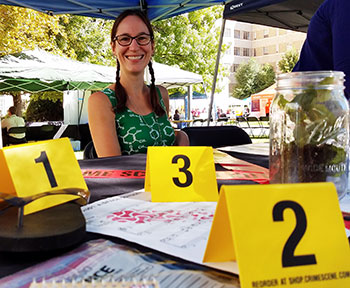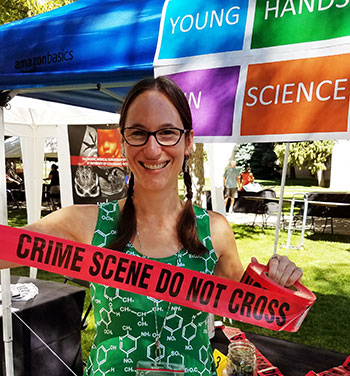Young Hands in Science Promotes STEM Education
Campus Volunteers encourage grade schoolers to study science
By Tonia Twichell

(October 2018) Madeline Keleher’s science education began when she was young. Her father, a lawyer by training “but a scientist at heart,” started taking her to the zoo every week when she was an infant. As she grew older, the family camped, hiked, went on birding excursions, and spent afternoons in Chicago’s Field Museum.
Keleher,
Sponsored by the CU Postdoctoral Association and run by volunteers from the Anschutz Medical Campus, the group promotes diversity in the fields of science, technology, engineering, and mathematics.
In fourth- and fifth-grade classrooms, volunteers craft a scenario for students to use science. They tell students a cafeteria worker has been kidnapped, then guide them through forensic experiments to solve the fictitious crime. Evidence includes a partly eaten sandwich, fingerprints, a mystery powder, and a note.
Students do their own forensic work. To eliminate themselves as suspects, they take their own fingerprints and swab their cheeks for DNA.
“The kids really get into it,” said Sarah Farabi,

“This is supposed to be mutually beneficial to the student and to the scientist. Students learn but it also supports postdocs who want to work on their science communications skills,” Farabi said. “A lot of scientists are interested in academic careers and one tenet of tenure is to show teaching and service, so they obviously need to learn to teach, and there really aren’t a lot of opportunities for postdocs to work on these skills.”
Keleher, the new director of the program, expanded the Young Hands in Science offerings to include a homeostasis lesson for high school students. Using stethoscopes, oximeters, and blood pressure cuffs “we can teach them how to take their own vitals to see how your body maintains homeostasis, and what happens to your body if you get injured or sick.
“At the end of the day, what’s important is that they learn something and see that science can be fun, and it’s more than just sitting in boring class every day.”
The classes make an impression on the kids, and, according to some of the thank-you notes students write, many have decided that they want to be scientists.
“I think this is really important because all of us know that we wouldn’t have gotten to where we are today if someone somewhere hadn’t gotten us excited about science,” Keleher said.